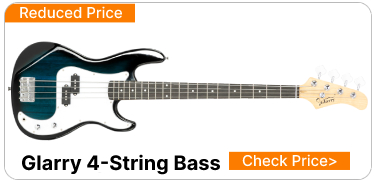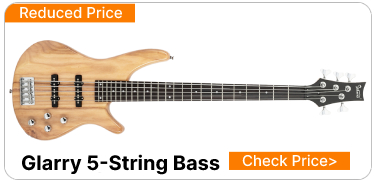4-String, 5-String, or 6-String? Which Bass Guitar is Right for You?
April 20, 2023
9977 Views
4-string, 5-string, and 6-string bass guitars are often compared by musicians and music enthusiasts alike, leading to questions about which variant is the best. In this article, we will provide a comprehensive comparison of these three types of bass guitars and a buying guide to help you make an informed decision when choosing your next instrument.
4-String Bass Guitars
4-string bass guitar is the most common and widely used type of bass guitar. It has been around since the 1950s and is popular among bassists because it is easy to play, lightweight, and has a straightforward design that makes it suitable for most genres of music.
The standard tuning for a 4-string bass guitar is E-A-D-G, with G going from the bottom to the top string. More precisely, this is E1, A1, D2, and G2, which is exactly one octave below a 6-string guitar’s 4 bottom strings. It provides a range of notes that are suitable for most styles of music, including rock, pop, funk, and jazz.
Out of the three main bass variants these days, 4-string bass is considered to be the easiest to play. This is due to having only 4 strings, as well as shorter scale lengths and smaller necks. This is why a lot of beginner musicians and music enthusiasts go with a 4-string bass guitar.
Additionally, there will be a wider range of models available if you stick with the standard number of strings, and the instruments are, on average, cheaper.
Click here if you want one:Glarry® 4-String Bass Guitar
5-String Bass Guitars
5-string bass guitar has an additional low B string, extending the range of the bass guitar. It has become increasingly popular over the years and is favored among bassists who play heavy metal, progressive rock, and other genres that require a lower tuning.
The standard 5-string bass comes with a bottom B string, so it goes B0, E1, A1, D2, G2. This is an octave lower than the bottom 5 strings of a 7-string guitar. Aside from the B standard, we have the drop A or A standard.
5-string bass is usually considered to be more challenging compared to 4-string ones. This is mostly due to the different neck widths and thicknesses that require the fretting hand to get accustomed to. Additionally, you need to be more precise with your slapping technique.
Click here if you want one:Glarry® 5-String Bass Guitar
6-String Bass Guitars
6-string bass comes with one additional high C string at the top and one additional B string at the bottom, extending the range of notes available on both sides. It is most commonly used in jazz, fusion, progressive rock, progressive metal, and other genres that require higher tuning. It's also not uncommon to see it in Latin and pop music.
From the bottom to the highest string, the standard tuning on a 6-string bass goes B0, E1, A1, D2, G2, C3. Of course, this can change depending on the needs of a bass player. Some prefer to go with B0, E1, A1, D2, F#2, B2, a tuning that has the same distribution of intervals as a 6-string guitar.
Additionally, a 6-string bass has a very specific use. It’s mostly an instrument that should also serve a lead role in some cases. Or, at least it would double down on some of the lead guitar parts and make them sound unique.
An instrument like a 6-string bass is way more challenging compared to a 4-string one. With wider and thicker necks, they require more experienced players. Overall, 6-string bass is great for soloists, prog, and fusion players who like pushing the boundaries of the instrument to the limit, and for those who have understanding bandmates.
Click here if you want one:Glarry® 6-String Bass Guitar
Comparison
If you want a short answer about what are the differences between 4, 5, and 6 string bass guitars, here it is:
4 string basses are the standard and what 95% of players might ever need. 5 string basses incorporate a lower B string that sounds great and is very usable in the most common tonalities. 6 string basses add a high C string that works great for soloists.
Which One is Right for You?
4-string, 5-string, and 6-string bass guitars all have their unique features that make them suitable for different playing styles and genres of music. When choosing a bass guitar, it is essential to consider your playing style, the genre of music you want to play, and your level of experience. With the right bass guitar, you can take your playing to the next level and create amazing music.
If you have any questions or thoughts, please contact us at [email protected]. Thank you for your interest.






